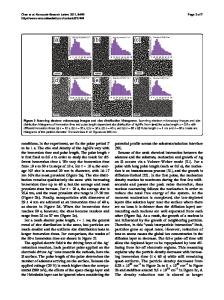Microsphere-assisted Fabrication of Ultra-high Aspect-ratio PDMS Micropillars for Bio-inspired Acoustic Sensing
- PDF / 689,129 Bytes
- 6 Pages / 612 x 792 pts (letter) Page_size
- 42 Downloads / 282 Views
Microsphere-assisted Fabrication of Ultra-high Aspect-ratio PDMS Micropillars for Bio-inspired Acoustic Sensing
Jungwook Paek and Jaeyoun Kim Department of Electrical and Computer Engineering, Iowa State University, Ames, Iowa, USA ABSTRACT We developed a new soft-lithographic fabrication technique which enables the realization of high aspect-ratio PDMS micropillars. The key enabling factor is the adoption of the direct drawing technique incorporated with the in situ heating for simultaneous hardening and solidification of the PDMS micropillars. In addition, our technique allows self-aligned installation of highly reflective microspheres at the tips of the micropillars. Using the transparent PDMS micropillar as a flexible waveguide and the microsphere as a self-aligned reflector, we transformed the microsphere-tipped PDMS micropillars into all optically interrogated acoustic sensors inspired by the cricket’s filiform hairs and successfully demonstrated the sensing capability. INTRODUCTION Nature is replete with tiny wind and sound sensors such as the cricket’s cercal acoustic receptors shown in figure 1 [1]. Using their thin and long filiform hairs, the receptors produce excellent performance in acoustic sensing, attracting numerous attempts to mimic them [2]. However, their replication requires high aspect-ratio micropillars, which is a great difficulty when attempted with conventional, replica-molding-based fabrication techniques and elastomeric material such as PDMS [3]. The main obstacle is the need to de-mold the PDMS micropillars after curing. Despite the efforts to improve the yield of the process [4], the failure rate increases inevitably with the aspect-ratio. Another source of difficulty is the inherently low Young’s modulus, EY of PDMS (typically ~1 MPa) [5], which frequently leads to the collapse of the micropillar and then irreversible bonding to the substrate [6]. For these reasons, the height and aspect-ratio of PDMS micropillars have been capped at ~700 m and ~20 so far [3], respectively. Here, we present a new technique, which enables the realization of PDMS micropillars with unprecedented aspect-ratios (40 ~112), through a combined utilization of direct drawing and in situ thermal hardening [7]. Our technique also allows automatic integration of multifunctional microspheres at the tips of the micropillars in a self-aligned fashion. To validate the utility of the microsphere-tipped micropillar (MSMP), we configure it into all-optically interrogated airflow sensors inspired by the filiform hairs.
Figure 1. The cricket’s cercus hosts a large number of filiform hairs as shown in the inset (from Ref. 1).They deform in response to airflows and generate signals for wind and sound reception.
EXPERIMENT Fabrication of PDMS micropillars The PDMS MSMPs (microsphere-tipped micropillars) fabrication steps are depicted in figure 2. We started out with the preparation of the drawing probe array. For this work, the microspheres were first assembled on a photo-lithographically patterned Su-8 grid and then tran
Data Loading...











